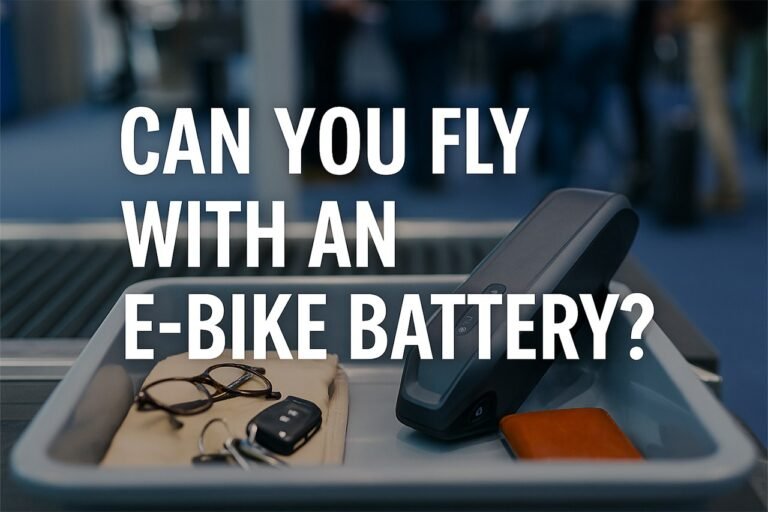
Cleaning an electric bike might seem tricky with all those electrical parts, but it’s actually pretty straightforward once you know the right steps. Many e-bike owners worry about damaging their battery or motor, but proper cleaning is essential for keeping your ride in top shape.
To clean an e-bike safely, remove the battery first, then use a damp cloth and mild soap to wipe down the frame while avoiding direct water spray on electrical components. The drivetrain and chain need special attention with degreaser, and everything should be dried thoroughly before reassembling.
This guide covers everything from gathering the right supplies to safely washing your electric bike without damaging sensitive parts. Readers will learn proper e-bike cleaning techniques, common mistakes to avoid, and how regular maintenance keeps their electric bike running smoothly for years.
Essential Supplies and Preparation
Proper preparation and the right tools make e-bike cleaning safer and more effective. Protecting electrical parts and using bike-specific products prevents damage while ensuring a thorough clean.
For riders who need portability, a lightweight folding e-bike can make storage and cleaning much easier.
Gathering Safe Cleaning Tools
The right cleaning supplies make all the difference when washing an e-bike. Using household cleaners can damage delicate components or strip protective coatings.
Essential cleaning supplies include:
- Bike cleaner (never use dish soap or harsh detergents)
- Bicycle degreaser for drivetrain components
- Chain cleaner specifically designed for bike chains
- Soft-bristled brushes in various sizes
- Microfiber cloths and sponges
- Disc brake cleaner (keep away from brake pads)
Bike-specific cleaners work better than generic products because they’re formulated for bike materials. They won’t harm paint, rubber seals, or metal components.
A toothbrush works great for detailed cleaning around gears and tight spaces. Avoid steel wool or abrasive scrubbers that can scratch surfaces.
Prepping Your E-Bike Before Washing
Smart preparation prevents water damage and makes cleaning more efficient. Taking a few minutes to prep saves hours of potential repair work later.
Remove the battery first – this is the most important step for e-bike maintenance. Water and electricity don’t mix, and removing the battery protects expensive components.
Turn off the bike completely before starting. Check that all electrical connections have proper covers or caps in place.
Position the bike in a shaded area away from direct sunlight. Hot surfaces can cause cleaning products to dry too quickly and leave streaks.
Avoid high-pressure water near electrical components, bearings, and sealed areas. Use a gentle spray or bucket of water instead.
Protecting Electrical Components
E-bikes have sensitive electrical parts that need extra protection during cleaning. A little care prevents costly damage to motors, displays, and wiring.
Cover the motor housing with a plastic bag or cloth. Even though most e-bike motors are water-resistant, soap and degreasers can still cause problems.
Protect the display screen and control buttons with a dry cloth. Water can seep into button gaps and cause malfunctions.
Key areas to keep dry:
- Charging port (should have a rubber cover)
- Display unit and controls
- Motor housing and connections
- Battery compartment
- Wiring harnesses and connectors
Use a damp cloth instead of spraying water directly on electrical areas. This gives better control and reduces the risk of water intrusion.
Step-By-Step Guide to Cleaning Your E-Bike
Proper e-bike cleaning requires a systematic approach that protects electrical components while removing dirt and grime effectively. The key is using gentle washing techniques for the frame, targeted methods for stubborn debris, and careful rinsing around sensitive parts.
Washing the Frame and Wheels
Start by removing the battery from your e-bike for safety and better access to all areas. This simple step prevents water damage to electrical connections and makes the bike lighter to handle.
Fill a bucket with warm, soapy water and grab a soft-bristled brush or sponge. Mild dish soap works perfectly – there’s no need for harsh chemicals that might damage the paint or components.
Frame Cleaning Process:
- Work from top to bottom to avoid re-soiling clean areas
- Use circular motions with gentle pressure
- Pay extra attention to the bottom bracket and seat post areas
- Clean the display screen with a barely damp cloth
The wheels need special attention since they collect the most dirt. Scrub the rims thoroughly, but avoid getting soap on the brake rotors. Clean spokes individually with a smaller brush to remove trapped debris.
Don’t forget the tire treads – use an old toothbrush to dig out embedded stones and debris that could cause punctures later.
Tackling Tough Mud and Debris
Dried mud and stubborn grime require patience rather than force. Let warm soapy water sit on problem areas for 2-3 minutes to soften the buildup before scrubbing.
For the drivetrain, start by cleaning this area first to prevent spreading dirt during the rest of the cleaning process. Use a dedicated degreaser on the chain, cassette, and derailleur.
Effective Mud Removal Tools:
- Soft plastic scrapers for large chunks
- Old toothbrushes for chain links and gear teeth
- Bottle brushes for hard-to-reach frame joints
- Microfiber cloths for final polishing
Work methodically around each component. The chain needs individual attention – shift through all gears while pedaling by hand to expose every link for cleaning.
Avoid using metal tools or abrasive brushes that could scratch painted surfaces or damage delicate components.
Rinsing Techniques for Delicate Components
Water pressure is the enemy when you clean your e-bike’s electrical parts. Never use high-pressure hoses or power washers that can force water into sealed bearings and electrical connections.
Instead, use a gentle stream from a regular garden hose or pour water from a pitcher. Keep the water flow at least 12 inches away from the motor, display, and any electrical connections.
Safe Rinsing Approach:
- Rinse from multiple angles using low pressure
- Immediately dry electrical areas with a clean towel
- Tilt the bike to drain water from frame tubes
- Use compressed air for tight spaces if available
Pay special attention to the motor housing and battery compartment. These areas should barely get wet – just enough to remove soap residue without soaking.
After rinsing, dry everything thoroughly with clean towels. Don’t skip this step, as trapped moisture leads to corrosion and electrical problems down the road.
How to Clean the Drivetrain and Chain
The drivetrain is where most dirt and grime collect on an e-bike, making it the messiest part to clean but also the most important. Proper degreasing prevents dirt from spreading to other bike parts during cleaning, while the right tools and lubrication keep everything running smoothly.
Using Bicycle Degreaser Correctly
A good bicycle degreaser cuts through built-up grease and grime that water alone can’t touch. Riders should apply degreaser generously to the chain, cassette, and derailleur pulleys.
Let the degreaser sit for 2-3 minutes to break down stubborn dirt. This waiting period makes scrubbing much easier and more effective.
Important safety tip: Keep degreaser away from the e-bike motor housing. Too much degreaser can push factory grease out of drive bearings, causing expensive damage later.
Use these application methods:
- Spray degreaser – Quick and easy for light cleaning
- Brush-on degreaser – Better control for heavily soiled chains
- Chain cleaning device – Contains mess while scrubbing
After the degreaser works its magic, scrub with an old toothbrush or chain brush. Rinse thoroughly with low-pressure water to remove all residue.
Chain Cleaning Tools and Methods
A basic chain cleaner setup doesn’t require expensive tools – just the right approach. Start with warm soapy water and a stiff brush to remove surface dirt.
For stubborn grime, a chain cleaning tool works wonders. These plastic devices clamp around the chain and use brushes inside to scrub while pedaling backward.
Essential cleaning tools:
- Old toothbrush for tight spaces
- Chain brush with stiff bristles
- Clean rags for wiping
- Chain cleaning device (optional but helpful)
The pedal-and-clean method works best. Hold the cleaning brush against the chain while slowly pedaling backward. This rotates the entire chain through the cleaning process.
Pay special attention to the cassette teeth and derailleur pulleys. These areas collect the most debris and affect shifting performance when dirty.
Lubricating After Cleaning
A clean chain needs proper lubrication to prevent rust and ensure smooth operation. Wait until the chain is completely dry before applying any lubricant.
Choose the right chain oil for riding conditions. Dry lube works best in dusty environments, while wet lube handles rain and mud better.
Apply lubricant to each chain link while pedaling backward slowly. One drop per link is plenty – more creates a dirt magnet.
Lubrication steps:
- Clean chain thoroughly and let dry
- Apply one drop per chain link
- Pedal backward 10-15 times to distribute
- Wipe excess oil with clean rag
After spreading the lubricant, wipe the chain’s exterior with a clean rag. This removes excess oil that would otherwise attract dirt and debris during the next ride.
Don’t forget the derailleur pivots and cable housing. A light spray of dry lubricant keeps these parts moving smoothly for better e-bike maintenance overall.
Electrical and Battery Care During Cleaning
Water and electricity don’t mix, so protecting your e-bike’s motor, battery, and display requires special care. The key is removing the battery before cleaning and avoiding high-pressure water near sensitive components.
Cleaning Around the Motor and Display
The motor and display are the most vulnerable parts of your electric bike during cleaning. Never use high-pressure water or spray these areas directly.
Use a damp cloth with mild soap to gently wipe around the motor housing. Avoid getting water into any vents or openings where the motor connects to the frame.
For the display screen, use a barely damp microfiber cloth. Most e-bike displays have some water resistance, but it’s better to be safe than sorry.
Protected cleaning approach:
- Use low-pressure water only
- Cover display with a plastic bag if needed
- Wipe motor area instead of spraying
- Keep electrical connections dry
Pay special attention to where cables enter the motor or connect to the battery mount. These spots can let water seep into sensitive electronics if you’re not careful.
Removing and Cleaning the Battery
Always remove the battery before cleaning your e-bike. This protects both the battery and the bike’s electrical system from water damage.
Most e-bike batteries slide out or unlock with a key. Check your owner’s manual for the exact removal process for your model.
Once removed, wipe the battery with a dry cloth to keep the connections clean. Don’t use water or cleaning products on the battery itself.
Clean the battery mount on the bike frame with a slightly damp cloth. Make sure no water pools in the battery compartment where electrical contacts sit.
Battery cleaning checklist:
- Remove battery completely
- Wipe battery case with dry cloth only
- Clean battery mount with damp cloth
- Dry mount area thoroughly before reinstalling
Drying Sensitive Areas
Proper drying prevents water from causing electrical problems later. Make sure the bike is completely dry before replacing the battery.
Use a clean, dry towel to wipe down all electrical components. Pay extra attention to the battery mount, motor area, and around the display.
Let the e-bike air dry for at least 30 minutes after towel drying. This ensures any remaining moisture evaporates completely.
Check that no water droplets remain in cable connections or the battery compartment. Even small amounts of moisture can cause corrosion or short circuits over time.
Common Mistakes and What to Avoid

Cleaning an e-bike requires a gentler approach than regular bikes due to sensitive electrical components. The biggest mistakes involve using too much water pressure and harsh cleaning products that can damage expensive parts.
Dangers of Pressure Washers
Never use a pressure washer or power washer on an e-bike. The high-pressure water stream can force moisture into electrical connections, causing permanent damage to the motor, battery, or display unit.
Even on the lowest setting, pressure washers create too much force. Water can penetrate seals around the motor housing and battery compartment. This leads to corrosion and electrical failures that cost hundreds of dollars to repair.
Garden hoses on full blast pose similar risks. The water pressure can push dirt and grime deeper into components rather than washing them away. Stick to gentle water flow from a hose or bucket washing instead.
Avoiding Harsh Chemicals
Strong degreasers and household cleaners can damage e-bike components. Ammonia-based products corrode aluminum frames and strip protective coatings from electrical housings.
Safe cleaning products include:
- Mild dish soap mixed with water
- Bike-specific cleaners
- White vinegar for stubborn grime
- Isopropyl alcohol for electrical contacts
Avoid bleach, engine degreasers, and automotive cleaners. These products are too aggressive for e-bike materials. They can also leave residues that attract more dirt over time.
Always test new cleaning products on a hidden area first. Some cleaners react poorly with specific paint finishes or plastic components.
Preventing Water Damage
Remove the battery before cleaning to protect the most expensive component. Keep water away from electrical contacts and cover the charging port with tape or a plastic bag.
Direct water away from the motor housing, display screen, and cable connections. Use damp cloths instead of spraying these areas directly. Pay special attention to where cables enter the frame.
After washing, dry the bike completely before reinstalling the battery. Water trapped in electrical connections causes corrosion even after the bike appears dry. Use compressed air to blow moisture from tight spaces and cable joints.
Post-Cleaning Maintenance and Regular Upkeep

Proper drying techniques prevent rust and electrical damage, while consistent cleaning schedules keep components running smoothly. Smart lubrication timing protects moving parts without attracting excess dirt.
Drying and Storing Your E-Bike
Never skip the drying step after cleaning your electric bike. Water left on components can cause rust on metal parts and damage electrical connections over time.
Use a clean, dry towel to wipe down all surfaces thoroughly. Pay special attention to the battery compartment, charging port, and display screen.
Key drying areas to focus on:
- Chain and drivetrain components
- Brake rotors and calipers
- Battery mounting points
- Motor housing exterior
- All electrical connections
Let your e-bike air dry for 15-20 minutes in a well-ventilated area before storing. This ensures any remaining moisture evaporates completely.
Store your clean e-bike in a dry location away from direct sunlight. Extreme temperatures can damage the battery and electronic components.
Scheduling Regular Cleaning
Clean your e-bike after every 3-4 rides in normal conditions. Increase this frequency to after every ride when cycling through mud, sand, or salty environments.
Regular e-bike maintenance extends component life significantly. Dirt buildup accelerates wear on moving parts and can clog sensitive areas.
Create a simple cleaning schedule based on your riding habits:
| Riding Conditions | Cleaning Frequency | Deep Clean |
|---|---|---|
| Dry roads/paths | Every 4-5 rides | Monthly |
| Light dirt/dust | Every 3 rides | Bi-weekly |
| Mud/wet conditions | After each ride | Weekly |
Quick post-ride wipe-downs take just 5 minutes but prevent major cleaning sessions later. Focus on removing visible dirt from the frame and drivetrain.
Inspections and Lubrication Tips
Check your chain, cables, and pivot points during each cleaning session. Look for signs of wear, corrosion, or damage that need attention.
Apply chain lubricant only after the drivetrain is completely clean and dry. Too much lube attracts dirt and creates a grinding paste that wears components faster.
Essential lubrication points:
- Chain (every 100-150 miles)
- Derailleur pivot points
- Brake and shifter cables
- Suspension pivot bearings (if equipped)
Wipe excess lubricant off all surfaces after application. Only moving parts should remain slightly oily to the touch.
Inspect brake pads and rotors for wear during cleaning. Replace pads when they’re less than 2mm thick or making grinding noises.
Final Thoughts
Cleaning an e-bike doesn’t have to feel like rocket science. With the right approach, anyone can keep their electric bike sparkling clean and running smoothly.
The key is remembering that e-bikes need a gentler touch than regular bikes. Water and electricity still don’t play nice together, so avoiding high-pressure hoses and protecting sensitive components is crucial.
Essential cleaning reminders:
- Remove the battery before starting any cleaning
- Use mild soap and a damp cloth instead of harsh chemicals
- Check brake functionality after each cleaning session
- Dry everything thoroughly before reassembling
Regular cleaning keeps e-bikes looking great and performing at their best. It also helps riders spot potential issues before they become expensive problems.
Safely washing electric bikes becomes second nature with practice. Most riders find their cleaning routine gets faster and more efficient over time.
The investment in proper cleaning pays off through better performance and longer bike life. Plus, there’s something satisfying about riding a spotless e-bike that turns heads on the trail.












